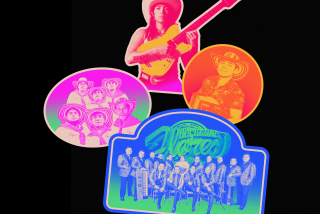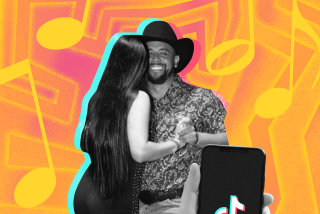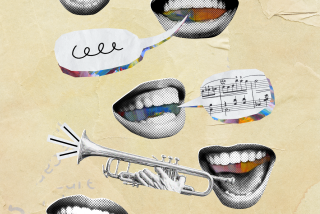Dancing to the beat of another country
Margit Edwards vividly remembers the exact moment she understood how to dance the samba.
On a beach in Brazil — swept up in the power of an impromptu samba beat, a little cachaça (made from fermented sugarcane) and the feel of her feet on the sand — she was hypnotized by watching the dancers’ midsections and realized: “It’s all in the bellybutton!”
FOR THE RECORD:
Dance tours: An information box accompanying a March 21 article on L.A.-based dance troupes that take trips overseas said airfare was not included in the Bahia travel program of Los Angeles-based Viver Brasil. The $3,350 price, based on double occupancy, includes round-trip airfare to Salvador Bahia, Brazil. —
Edwards, an arts administrator in L.A. , had traveled to Brazil to live out her “dance fantasy,” as she calls it, as a participant in the Los Angeles-based dance company Viver Brasil’s Bahia travel program. For the last 11 years, the group has brought dance and drum enthusiasts to Salvador Bahia for two weeks of intensive classes and cultural immersion.
And now, other local dance companies are following in Viver Brasil’s footsteps, taking similar trips to their choreographic countries of origin. Contra-Tiempo, whose brand of urban Latin dance theater blends salsa, Afro-Cuban and hip-hop, began leading trips to Havana and Santiago, Cuba, in 2008. The Baker & Tarpaga Dance Project, whose choreography melds postmodern and traditional West African techniques, last year led an inaugural trip to Burkina Faso. No matter the destination, the common aim of these programs is authentic cultural exchange through the intimacy of music and movement.
“Studying dance allows you an immediate view inside of a culture,” says Ana Maria Alvarez, founder and artistic director of Contra-Tiempo, who will take a group to Cuba again in January. “The way people dance is a way of listening to each other’s bodies and really connecting with one another.”
That possibility to help cultivate deep connections between Americans and Cubans — rare given the chilly political relations between the neighboring nations — appealed to Alvarez, who is Cuban American, as an extension of her company’s mission to bridge cultural divides through dance.
Besides master dance classes in rumba, salsa and folkloric forms, her travel program incorporates excursions to meet Cuban visual artists, tour medical clinics and dance in social clubs off the beaten tourist track.
Despite such a heady cultural itinerary, opportunities for spontaneous dancing abound.
“It sounds very cliché, but people are dancing in the streets, literally,” says Alvarez. “Cuban dance is such a part of life.”
From impromptu street parties to Santeria ceremonies, the group encounters dance around nearly every corner.
It’s not surprising that dance figures prominently in both secular and sacred aspects of Cuban society, given that many of the country’s dance forms evolved from the traditions of West Africans, who were initially brought to the island as slaves.
In Burkina Faso, says Esther Baker-Tarpaga, co-founder of the Baker & Tarpaga Dance Project, dance is “interwoven into the fabric of life in all sorts of rituals,” from weddings and birthday parties to the colorful nightlife in open-air music bars in Ouagadougou, the capital. Olivier Tarpaga, her husband and the company’s co-founder, who hails from Ouagadougou, led a group to his hometown last summer, where participants took dance and drum classes from the same teachers who had taught him.
“That’s how 80% to 90% of people on the continent become masters of dance and music,” he says. “It’s in the community.”
To showcase that sense of community, Tarpaga invites participants to take part in his family celebrations. In the classroom, Americans on the trip learn West African dance, such as kassena, an ancient warrior dance, and djembe percussion alongside students from Burkina Faso. The mixture allows for moments of cultural dialogue that couldn’t possibly be planned.
Participant Halie Kampman of Venice recalls the moment when her group joined a roomful of teenage girls from Burkina who were choreographing routines to American hip-hop music. Spontaneously, the girls pulled them into the dance. “They wanted us to do hip-hop; we wanted to see them do African [dance],” she says. “It was the essence of the exchange that we went for.”
Through such experiences, Kampman began deep and lasting relationships with the people of Burkina. After the two-week program ended, she stayed on in the country to volunteer and helped start a women’s bead-making collective; she now sells the beads locally to benefit them.
“Going [to Burkina] with Olivier and having him show us the culture and the people … instilled a love for me,” she says.
Making participants feel as close as family is also a strong goal in Linda Yudin’s trips to Bahia.
“When I go there, I say to everybody, ‘I’m going to introduce you to my second family,’ ” says Yudin, Viver Brasil’s founder and artistic director. In the last 2 1/2 decades, Yudin has formed intimate bonds with artists in Salvador Bahia, “the epicenter of Afro-Brazilian culture,” as she describes it.
As in Cuba, the legacy of West African culture in Bahia is profound. The local religious tradition known as Candomblé is rooted in Yoruba mythology and linked to Bahia’s dance and percussive expressions. Program participants can focus on either dance or drum classes in the mornings, while in the afternoons and evenings, visits to Candomblé houses and community arts organizations offer a window into cultural and political history. “We really get a deep context for what we’re dancing and singing and playing about,” says Yudin.
For L.A.-based percussionist and trip participant Kirk Brundage, the intense immersion in Brazilian music and culture proved life-changing. Before the trip, he was an orchestral musician who had been trained in European percussion, although he’d long had an interest in Latin rhythms. Enamored of the global gumbo of beats he encountered in Bahia, Brundage discovered a passion that led him to a new career focus in Afro-Brazilian technique and a lectureship in UCLA’s department of ethnomusicology.
“I no longer play the European music I was playing,” he says. “I just kept following my heart and then suddenly I ended up in another place.”
On all these trips, music and dance provide vehicles for opening oneself to new and previously unimagined possibilities. For Marina Magalhaes, who attended Contra-Tiempo’s Cuba trip two years in a row, the partnering tradition of salsa — in which a woman must give her complete trust as a follower to the man — became a metaphor for losing her inhibitions, in dance and in life.
What she remembers most “is that feeling of true letting go, [not just] in terms of emotion, but true letting go physically … with someone who came from a culture and a place that you didn’t even know until a week ago.” She joined the trip as an administrative assistant for Contra-Tiempo; today, she’s a dancer with the company.
Traveling as a student of dance and music promises lasting rewards that transcend the standard tourist experience. Says Edwards, whose on-the-beach samba epiphany touched off years of involvement in Afro-Brazilian dance in Los Angeles, “The souvenirs can wear out, get lost or whatever, but going as a dancer and learning dance … it’s forever with me. I will always know how to samba.”
More to Read
Sign up for The Wild
We’ll help you find the best places to hike, bike and run, as well as the perfect silent spots for meditation and yoga.
You may occasionally receive promotional content from the Los Angeles Times.






